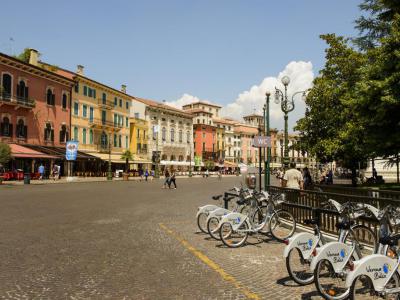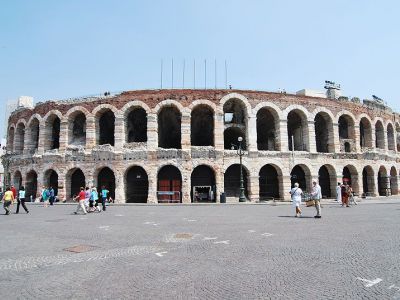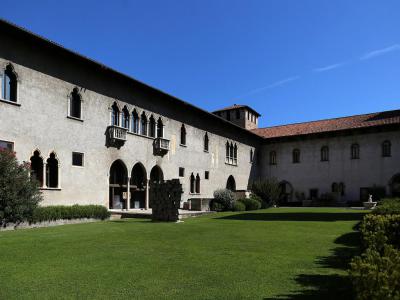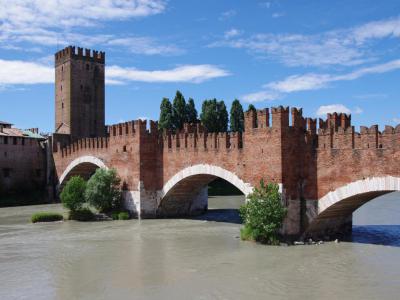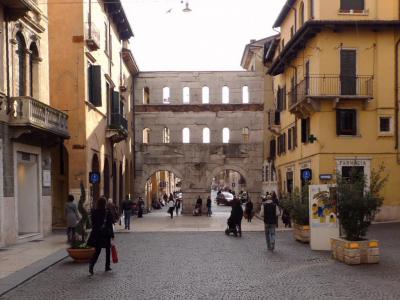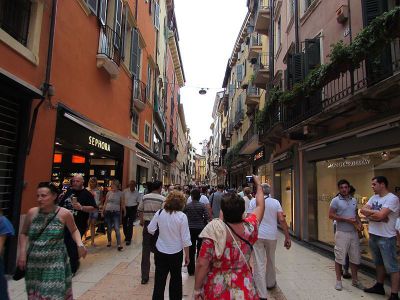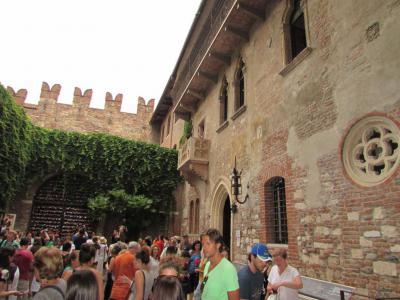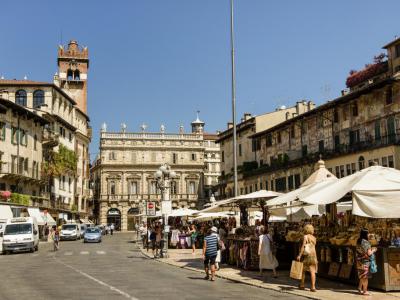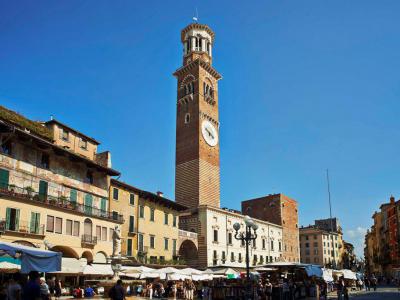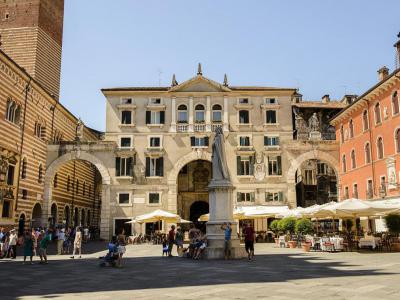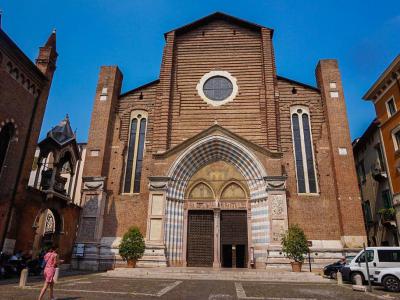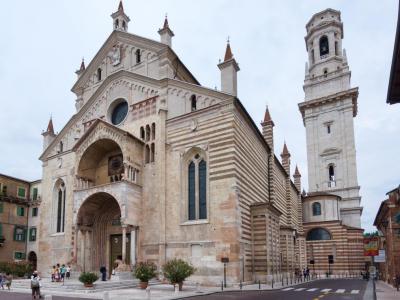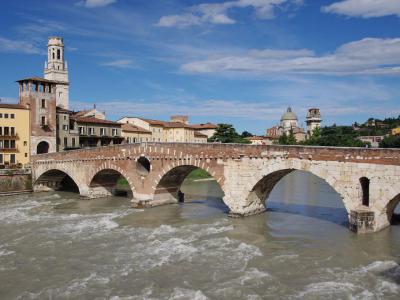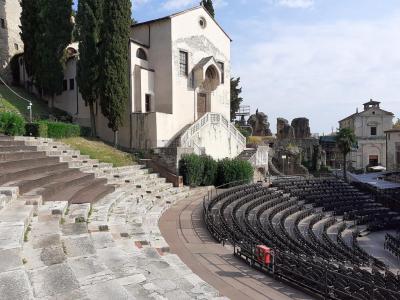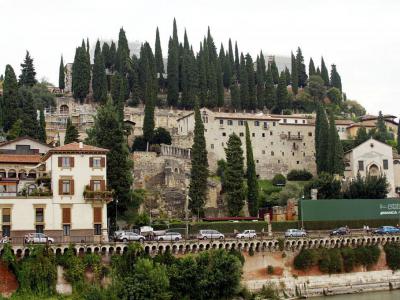Audio Guide: Verona Introduction Walking Tour (Self Guided), Verona
As William Shakespeare once wrote, “Two households, both alike in dignity, in fair Verona, where we lay our scene…” — a line that has forever entwined the city’s name with timeless romance and drama.
Verona is one of northern Italy’s most storied cities, shaped by ancient tribes, Roman expansion, medieval rivalries, and later cultural prosperity that earned it UNESCO World Heritage status. The origin of its name is uncertain, though many link “Verona” to Venetic or Celtic roots—possibly meaning “fortified height”, “river bend”, or a combination of “bank” and “water”, all highlighting its strategic position along the Adige River.
Originally inhabited by the Euganei and later Celtic tribes, Verona became a Roman colony in 89 BCE and soon flourished as a key crossroads between Rome and northern Europe. The Romans left enduring landmarks, including the 1st-century Verona Amphitheater, the Pietra bridge, and the city’s recognizable grid, which remain defining features today.
After the fall of the Western Roman Empire, Verona served as a stronghold under the Ostrogoths and later gained importance during Lombard rule. The Middle Ages brought shifting powers, including a period as an independent commune, followed by the influential Scaligeri family in the 13th–14th centuries.
In 1405, Verona passed to the Republic of Venice, enjoying centuries of stability and artistic growth. After Napoleon’s rule and subsequent Austrian control, it officially became part of the Kingdom of Italy in 1866, beginning a modern chapter in its long and layered story.
Today, Verona is celebrated not only for its rich architectural and historical heritage but also for its literary fame as the backdrop of Romeo and Juliet. A stroll through the historic centre reveals this blend in a compact, elegant setting: the bustling Market Square, Juliet’s House with its famed balcony, and the scenic Adige River views near the Old Castle and its fortified bridge.
And as you explore these streets, you may find that “fair Verona” is more than the setting of a story—it is a stage where history, romance, and imagination still share the spotlight.
Verona is one of northern Italy’s most storied cities, shaped by ancient tribes, Roman expansion, medieval rivalries, and later cultural prosperity that earned it UNESCO World Heritage status. The origin of its name is uncertain, though many link “Verona” to Venetic or Celtic roots—possibly meaning “fortified height”, “river bend”, or a combination of “bank” and “water”, all highlighting its strategic position along the Adige River.
Originally inhabited by the Euganei and later Celtic tribes, Verona became a Roman colony in 89 BCE and soon flourished as a key crossroads between Rome and northern Europe. The Romans left enduring landmarks, including the 1st-century Verona Amphitheater, the Pietra bridge, and the city’s recognizable grid, which remain defining features today.
After the fall of the Western Roman Empire, Verona served as a stronghold under the Ostrogoths and later gained importance during Lombard rule. The Middle Ages brought shifting powers, including a period as an independent commune, followed by the influential Scaligeri family in the 13th–14th centuries.
In 1405, Verona passed to the Republic of Venice, enjoying centuries of stability and artistic growth. After Napoleon’s rule and subsequent Austrian control, it officially became part of the Kingdom of Italy in 1866, beginning a modern chapter in its long and layered story.
Today, Verona is celebrated not only for its rich architectural and historical heritage but also for its literary fame as the backdrop of Romeo and Juliet. A stroll through the historic centre reveals this blend in a compact, elegant setting: the bustling Market Square, Juliet’s House with its famed balcony, and the scenic Adige River views near the Old Castle and its fortified bridge.
And as you explore these streets, you may find that “fair Verona” is more than the setting of a story—it is a stage where history, romance, and imagination still share the spotlight.
How it works: Download the app "GPSmyCity: Walks in 1K+ Cities" from Apple App Store or Google Play Store to your mobile phone or tablet. The app turns your mobile device into a personal tour guide and its built-in GPS navigation functions guide you from one tour stop to next. The app works offline, so no data plan is needed when traveling abroad.
Verona Introduction Walking Tour Map
Guide Name: Verona Introduction Walking Tour
Guide Location: Italy » Verona (See other walking tours in Verona)
Guide Type: Self-guided Walking Tour (Sightseeing)
# of Attractions: 16
Tour Duration: 3 Hour(s)
Travel Distance: 4.0 Km or 2.5 Miles
Author: Helen
Sight(s) Featured in This Guide:
Guide Location: Italy » Verona (See other walking tours in Verona)
Guide Type: Self-guided Walking Tour (Sightseeing)
# of Attractions: 16
Tour Duration: 3 Hour(s)
Travel Distance: 4.0 Km or 2.5 Miles
Author: Helen
Sight(s) Featured in This Guide:
- Piazza Bra (Bra Square)
- Arena di Verona (Verona Amphitheater)
- Museo di Castelvecchio (Old Castle Museum)
- Ponte Scaligero (Scaligero Bridge)
- Corso e Porta Borsari (Borsari Gate and Street)
- Via Mazzini (Mazzini Street)
- Casa de Giulietta (House of Juliet)
- Piazza delle Erbe (Market Square)
- Torre dei Lamberti (Lamberti Tower)
- Piazza dei Signori (Lords Square)
- Arche Scaligere (Scaligeri Tombs)
- Saint Anastasia Church
- Verona Cathedral
- Ponte Pietra (Stone Bridge)
- Teatro Romano (Roman Theatre)
- Piazzale Castel San Pietro (San Pietro Fortress)
1) Piazza Bra (Bra Square) (must see)
Bra Square, often simply called “La Bra”, is the largest and most prominent square in Verona. Positioned at the edge of the historic center, it acts as a welcoming entrance to the city’s most celebrated landmarks. Its name derives from the Lombard word braida, meaning “wide open space”, a reminder of when this area lay just beyond the Roman city walls, used as an open field for markets and gatherings.
The square began to develop its current shape in the Middle Ages, as Verona expanded outward from the ancient core. Over the centuries, noble families and city authorities commissioned grand residences and civic buildings around the perimeter. By the 17th and 18th centuries, the area had transformed into an elegant public space, reflecting influences from Palladian and later Neoclassical styles. It has hosted everything from military parades to community celebrations and remains one of the busiest civic squares in northern Italy.
The dominant feature of the square is the Verona Arena, a 1st-century Roman amphitheater renowned for its impressive state of preservation and exceptional acoustics. Nearby stands Barbieri Palace, Verona’s neoclassical City Hall, completed in the mid-19th century, and Gran Guardia Palace, a large 17th-century building that now serves as a venue for major exhibitions and cultural events.
Visitors can stroll along the Liston, the marble-paved walkway lined with cafés and restaurants — a popular place to sit outdoors and enjoy the atmosphere. On the southern side, small green gardens provide shaded seating and feature monuments such as the Bersaglieri Monument, dedicated to Italy’s historic light infantry regiment. Traces of the ancient Roman walls and later fortifications remain are also visible.
The square began to develop its current shape in the Middle Ages, as Verona expanded outward from the ancient core. Over the centuries, noble families and city authorities commissioned grand residences and civic buildings around the perimeter. By the 17th and 18th centuries, the area had transformed into an elegant public space, reflecting influences from Palladian and later Neoclassical styles. It has hosted everything from military parades to community celebrations and remains one of the busiest civic squares in northern Italy.
The dominant feature of the square is the Verona Arena, a 1st-century Roman amphitheater renowned for its impressive state of preservation and exceptional acoustics. Nearby stands Barbieri Palace, Verona’s neoclassical City Hall, completed in the mid-19th century, and Gran Guardia Palace, a large 17th-century building that now serves as a venue for major exhibitions and cultural events.
Visitors can stroll along the Liston, the marble-paved walkway lined with cafés and restaurants — a popular place to sit outdoors and enjoy the atmosphere. On the southern side, small green gardens provide shaded seating and feature monuments such as the Bersaglieri Monument, dedicated to Italy’s historic light infantry regiment. Traces of the ancient Roman walls and later fortifications remain are also visible.
2) Arena di Verona (Verona Amphitheater) (must see)
Verona Amphitheater stands as one of the most remarkable Roman amphitheatres still in existence. Built around 30 AD, it once formed the lively heart of entertainment in ancient Verona. Its elliptical shape, strong stone arches, and imposing tiers made it a masterpiece of Roman engineering, perfectly designed to host crowds who came to witness gladiatorial combat and public spectacles. Today, more than 500,000 visitors each year step into the Arena to reconnect with this extraordinary past.
Constructed from pink and white limestone quarried in nearby Valpolicella, the amphitheatre originally seated up to 30,000 spectators. A devastating earthquake in 1117 damaged the structure and destroyed most of its outer ring, leaving only a single surviving portion, known as the “Wing”. Even with a reduced capacity of around 22,000, the Arena still conveys the scale and innovation that made it one of the largest venues in the Roman world.
In the modern era, the Arena has earned international acclaim as the home of the Verona Opera Festival, held every summer beneath the open sky. Its acoustics are so exceptional that performers often sing without amplification, their voices carried naturally through the ancient stone. Legendary operatic stars such as Maria Callas, Plácido Domingo, and Luciano Pavarotti have graced this stage, along with world-renowned rock and pop artists.
Visiting the Arena offers a chance to explore its historic passageways, climb the stone seating tiers, and admire views across Bra Square. Yet the most unforgettable experience comes at night, when the amphitheatre glows beneath the lights and a performance begins.
Constructed from pink and white limestone quarried in nearby Valpolicella, the amphitheatre originally seated up to 30,000 spectators. A devastating earthquake in 1117 damaged the structure and destroyed most of its outer ring, leaving only a single surviving portion, known as the “Wing”. Even with a reduced capacity of around 22,000, the Arena still conveys the scale and innovation that made it one of the largest venues in the Roman world.
In the modern era, the Arena has earned international acclaim as the home of the Verona Opera Festival, held every summer beneath the open sky. Its acoustics are so exceptional that performers often sing without amplification, their voices carried naturally through the ancient stone. Legendary operatic stars such as Maria Callas, Plácido Domingo, and Luciano Pavarotti have graced this stage, along with world-renowned rock and pop artists.
Visiting the Arena offers a chance to explore its historic passageways, climb the stone seating tiers, and admire views across Bra Square. Yet the most unforgettable experience comes at night, when the amphitheatre glows beneath the lights and a performance begins.
3) Museo di Castelvecchio (Old Castle Museum) (must see)
The Old Castle Museum, better known as the Castelvecchio Museum, is housed within the city’s impressive medieval fortress. Built between 1354 and 1356 by the Scaliger family to protect Verona’s rulers and provide a strategic escape route, the castle later served as a major military stronghold. During the 15th century, it stored weapons and munitions, and by the 18th century it had become the seat of the Venetian military academy. In 1923, the historic structure was transformed into a museum. Its location on the riverbank was deliberately chosen to ensure rapid escape across the bridge toward the Scaligers’ allies in northern territories.
Today, the museum’s collections span from the 12th to the 18th centuries, featuring Veronese sculptures, frescoes, paintings, ceramics, jewelry, weapons, and bells. Highlights include the Sepulcher of Saints Sergius and Bacchus, the Crucifix, the graceful Madonna of the Quail, and depictions of the Holy Family and revered saints. Works by major Italian artists such as Giovanni Bellini, Pisanello, and Paolo Veronese reflect Verona’s rich artistic heritage within the wider context of northern Italy.
The castle has undergone numerous modifications over its 700-year history. A major restoration led by architect Carlo Scarpa between 1958 and 1974 revived its medieval character. Scarpa’s design approach is now considered a masterpiece of 20th-century museum architecture, carefully combining historic structures with modern materials like concrete and iron to highlight the building’s evolution over time.
Exploring the museum is a delight, as its galleries lead through well-organised rooms, passageways, and open courtyards that reveal layers of history. Visitors can also walk along the battlements, where views of the Adige River and the Castelvecchio Bridge complete the experience. The bridge itself, known as Scaligero Bridge, was rebuilt after World War II, reconnecting the castle to its historic defensive route.
Today, the museum’s collections span from the 12th to the 18th centuries, featuring Veronese sculptures, frescoes, paintings, ceramics, jewelry, weapons, and bells. Highlights include the Sepulcher of Saints Sergius and Bacchus, the Crucifix, the graceful Madonna of the Quail, and depictions of the Holy Family and revered saints. Works by major Italian artists such as Giovanni Bellini, Pisanello, and Paolo Veronese reflect Verona’s rich artistic heritage within the wider context of northern Italy.
The castle has undergone numerous modifications over its 700-year history. A major restoration led by architect Carlo Scarpa between 1958 and 1974 revived its medieval character. Scarpa’s design approach is now considered a masterpiece of 20th-century museum architecture, carefully combining historic structures with modern materials like concrete and iron to highlight the building’s evolution over time.
Exploring the museum is a delight, as its galleries lead through well-organised rooms, passageways, and open courtyards that reveal layers of history. Visitors can also walk along the battlements, where views of the Adige River and the Castelvecchio Bridge complete the experience. The bridge itself, known as Scaligero Bridge, was rebuilt after World War II, reconnecting the castle to its historic defensive route.
4) Ponte Scaligero (Scaligero Bridge) (must see)
The Scaligero Bridge, also known as the Castelvecchio Bridge, is a remarkable three-arch span crossing the Adige River. Built around 1354 and 1356 by the Scaliger family, it served a vital defensive purpose as a swift escape route from the Old Castle toward the protection of the family’s allies in Tyrol, where ruler Cangrande II’s son-in-law held influence. Today, its elevated walkway provides stunning views of Verona and the river winding through the city.
Stretching roughly 120 meters, the bridge is one of Verona’s most photographed landmarks and remains a popular pedestrian route. The original structure was destroyed in 1945 by retreating German troops during World War II, but a meticulous reconstruction in the 1950s reused a significant portion of the recovered stonework, restoring the bridge closely to its medieval appearance. During reconstruction, archaeologists documented original Roman foundations beneath parts of the structure, highlighting the strategic importance of this river crossing long before the Scaligers’ fortifications.
Its fortified design — red brick battlements above and white stone below — gives the impression of a fortress set across the river. A charming local legend claims that the Lord of Verona rewarded the bridge’s anonymous engineer with Saint Martin’s sword for his success. Because the bridge was designed wide enough for mounted soldiers to cross quickly, it stood out as one of the most innovative defensive bridges of its time.
By day, the bridge’s crenellations appear bold and powerful, while at night, illuminated against the water, it becomes one of Verona’s most atmospheric and romantic sights. The viewpoint from the bridge also frames Saint Peter’s Castle in the distance, another historically significant hilltop fortification.
Stretching roughly 120 meters, the bridge is one of Verona’s most photographed landmarks and remains a popular pedestrian route. The original structure was destroyed in 1945 by retreating German troops during World War II, but a meticulous reconstruction in the 1950s reused a significant portion of the recovered stonework, restoring the bridge closely to its medieval appearance. During reconstruction, archaeologists documented original Roman foundations beneath parts of the structure, highlighting the strategic importance of this river crossing long before the Scaligers’ fortifications.
Its fortified design — red brick battlements above and white stone below — gives the impression of a fortress set across the river. A charming local legend claims that the Lord of Verona rewarded the bridge’s anonymous engineer with Saint Martin’s sword for his success. Because the bridge was designed wide enough for mounted soldiers to cross quickly, it stood out as one of the most innovative defensive bridges of its time.
By day, the bridge’s crenellations appear bold and powerful, while at night, illuminated against the water, it becomes one of Verona’s most atmospheric and romantic sights. The viewpoint from the bridge also frames Saint Peter’s Castle in the distance, another historically significant hilltop fortification.
5) Corso e Porta Borsari (Borsari Gate and Street)
One of the most enduring features of Verona’s ancient defenses is its network of Roman gates, once used to control access and protect the city. These monumental structures marked the official transition into the Roman settlement and still stand today as powerful reminders of Verona’s imperial past.
Borsari Gate originated in the late 1st century BC, likely replacing an even earlier entrance on the same site. In the 1st century AD, it was given the impressive limestone façade that survives today—decorated with two levels of arch-framed windows and elegant Corinthian pilasters. Its current name derives from the Bursarii, soldiers or toll collectors who once collected fees on behalf of the bishop.
In its original form, it functioned as a small fortified complex, featuring two façades and an internal courtyard. The outer façade visible today—remodeled in 265 AD—is all that remains, as the courtyard and rear arch have been lost over time.
From here begins Borsari Gate Street. This urban stretch was part of the major Roman highway Via Postumia, helping to transform Verona into a thriving crossroads of trade and culture across northern Italy. Today, it remains one of the city’s most lively streets, its Roman layout still guiding modern life.
Borsari Gate originated in the late 1st century BC, likely replacing an even earlier entrance on the same site. In the 1st century AD, it was given the impressive limestone façade that survives today—decorated with two levels of arch-framed windows and elegant Corinthian pilasters. Its current name derives from the Bursarii, soldiers or toll collectors who once collected fees on behalf of the bishop.
In its original form, it functioned as a small fortified complex, featuring two façades and an internal courtyard. The outer façade visible today—remodeled in 265 AD—is all that remains, as the courtyard and rear arch have been lost over time.
From here begins Borsari Gate Street. This urban stretch was part of the major Roman highway Via Postumia, helping to transform Verona into a thriving crossroads of trade and culture across northern Italy. Today, it remains one of the city’s most lively streets, its Roman layout still guiding modern life.
6) Via Mazzini (Mazzini Street) (must see)
Mazzini street is the most popular shopping street, where visitors browse boutique stores and enjoy a coffee or cocktail while watching the lively flow of people around them. Named after Giuseppe Mazzini, a key 19th-century political activist whose ideas helped shape the unification of Italy, the street celebrates one of the nation’s most influential figures.
Connecting the grand Bra Square to the historic Market Square, Mazzini street follows the alignment of a Roman decumanus. Segments near the Verona Arena trace the original Roman alignment, preserving more than two thousand years of city planning. While many of Europe’s ancient streets are paved with cobblestones, Mazzini street features polished marble paving that gives it a sleek, modern look.
Today, Mazzini street is home to a mix of Italy’s top fashion brands and major international labels. One standout is the United Colors of Benetton flagship store, beneath which Roman ruins — including 1st- and 2nd-century AD flooring and walls — were uncovered and are now visible to visitors. Other nearby archaeological findings have revealed fragments of ancient Verona’s residential blocks, suggesting the presence of a lively commercial quarter during Roman times.
Mazzini street became pedestrian-only in the late 20th century, contributing to its pleasant and accessible atmosphere. Its current appearance largely dates to major urban improvements made during the early 1900s, when façades were updated and the street began to develop its reputation as Verona’s fashion district.
Seasonal illuminations and window displays transform the street into a festive promenade, especially during the opera season and winter holidays. Street performers and pop-up markets occasionally add to the atmosphere, creating a lively blend of shopping and entertainment.
Connecting the grand Bra Square to the historic Market Square, Mazzini street follows the alignment of a Roman decumanus. Segments near the Verona Arena trace the original Roman alignment, preserving more than two thousand years of city planning. While many of Europe’s ancient streets are paved with cobblestones, Mazzini street features polished marble paving that gives it a sleek, modern look.
Today, Mazzini street is home to a mix of Italy’s top fashion brands and major international labels. One standout is the United Colors of Benetton flagship store, beneath which Roman ruins — including 1st- and 2nd-century AD flooring and walls — were uncovered and are now visible to visitors. Other nearby archaeological findings have revealed fragments of ancient Verona’s residential blocks, suggesting the presence of a lively commercial quarter during Roman times.
Mazzini street became pedestrian-only in the late 20th century, contributing to its pleasant and accessible atmosphere. Its current appearance largely dates to major urban improvements made during the early 1900s, when façades were updated and the street began to develop its reputation as Verona’s fashion district.
Seasonal illuminations and window displays transform the street into a festive promenade, especially during the opera season and winter holidays. Street performers and pop-up markets occasionally add to the atmosphere, creating a lively blend of shopping and entertainment.
7) Casa de Giulietta (House of Juliet) (must see)
The House of Juliet is one of the most famous landmarks associated with William Shakespeare’s Romeo and Juliet, often visited by those seeking to experience the legendary romance between Juliet Capulet and Romeo Montague. Though the story is fictional, the house itself has become a symbol of love and tragedy, drawing countless visitors who are eager to connect with Verona’s most romantic tale.
The house dates back to the 13th century and is believed to have belonged to the Cappelletti family, traditionally linked to Juliet’s fictional lineage. The most famous feature of the house is its balcony, now an enduring emblem of Juliet’s longing in the play. Visitors often picture the moment when Romeo whispers his devotion from below. Although the balcony itself was added during restoration in the 20th century, it remains one of the city’s most photographed sights and a key highlight for fans of Shakespeare’s work.
The building is a fine example of medieval architecture, featuring Gothic elements, a brick façade, and intricately carved details. In the courtyard, a bronze statue of Juliet stands beneath the balcony, and the tradition of rubbing its right breast for good luck in love has made it a popular spot for photos. The walls nearby are covered with love messages, notes, and padlocks left by couples hoping for lasting affection.
Inside, the house has been transformed into a museum, displaying period furnishings, costumes used in film adaptations, and exhibits about the cultural impact of Shakespeare’s tragic story. From its romantic folklore to its historical roots, the House of Juliet continues to inspire visitors from around the world with the enduring power of love and imagination.
The house dates back to the 13th century and is believed to have belonged to the Cappelletti family, traditionally linked to Juliet’s fictional lineage. The most famous feature of the house is its balcony, now an enduring emblem of Juliet’s longing in the play. Visitors often picture the moment when Romeo whispers his devotion from below. Although the balcony itself was added during restoration in the 20th century, it remains one of the city’s most photographed sights and a key highlight for fans of Shakespeare’s work.
The building is a fine example of medieval architecture, featuring Gothic elements, a brick façade, and intricately carved details. In the courtyard, a bronze statue of Juliet stands beneath the balcony, and the tradition of rubbing its right breast for good luck in love has made it a popular spot for photos. The walls nearby are covered with love messages, notes, and padlocks left by couples hoping for lasting affection.
Inside, the house has been transformed into a museum, displaying period furnishings, costumes used in film adaptations, and exhibits about the cultural impact of Shakespeare’s tragic story. From its romantic folklore to its historical roots, the House of Juliet continues to inspire visitors from around the world with the enduring power of love and imagination.
8) Piazza delle Erbe (Market Square) (must see)
Market Square stands on Verona’s former Roman forum, the center of civic and commercial life in antiquity. Its later name, “Square of Herbs”, recalls the long-running market where spices, produce, and household goods were traded. A weekday market still operates here from Monday to Saturday, continuing that historic role.
At the center of the square stands Madonna Verona, a Roman statue dating to the 4th century AD, set atop a fountain from 1368. Surrounding the piazza is a mix of structures that show how the area evolved after the Roman period. On the north side are the Mazzanti Houses, decorated with 14th-century frescoes, and the base of the Lamberti Tower, which rises behind the buildings and is accessible through a nearby courtyard.
On the northwest edge stands the Maffei Palace, a Baroque residence updated in the 17th century. Its façade is lined with statues of Hercules, Apollo, Minerva, Venus, Mercury, and Jupiter. Shops now occupy the ground floor. Close by are the archaeological remains of the Roman Capitolium, marking the site of Verona’s main Roman temple.
The south side features the House of the Merchants and the Capitello, a 13th-century structure once used for public proclamations. To the west is the Gardello Tower, restored in the 14th century and known for one of Verona’s earliest mechanical clocks. Through the archway at the eastern end, the square connects directly to Signori Square, where the historic Town Hall and the Palace of the Judges are located.
Today, Market Square remains active and walkable, with cafés and market stalls set among some of Verona’s most significant buildings.
At the center of the square stands Madonna Verona, a Roman statue dating to the 4th century AD, set atop a fountain from 1368. Surrounding the piazza is a mix of structures that show how the area evolved after the Roman period. On the north side are the Mazzanti Houses, decorated with 14th-century frescoes, and the base of the Lamberti Tower, which rises behind the buildings and is accessible through a nearby courtyard.
On the northwest edge stands the Maffei Palace, a Baroque residence updated in the 17th century. Its façade is lined with statues of Hercules, Apollo, Minerva, Venus, Mercury, and Jupiter. Shops now occupy the ground floor. Close by are the archaeological remains of the Roman Capitolium, marking the site of Verona’s main Roman temple.
The south side features the House of the Merchants and the Capitello, a 13th-century structure once used for public proclamations. To the west is the Gardello Tower, restored in the 14th century and known for one of Verona’s earliest mechanical clocks. Through the archway at the eastern end, the square connects directly to Signori Square, where the historic Town Hall and the Palace of the Judges are located.
Today, Market Square remains active and walkable, with cafés and market stalls set among some of Verona’s most significant buildings.
9) Torre dei Lamberti (Lamberti Tower) (must see)
Lamberti Tower is one of Verona’s most recognizable landmarks, built beginning in 1172 by the influential Lamberti family, at a time when prominent Veronese households constructed tall towers to express their wealth and political influence. Over the centuries, the tower has undergone several phases of modification, including a major restoration following a lightning strike in 1403. This reconstruction campaign, which lasted from 1448 to 1464, introduced visible changes in materials and extended the structure to its current height of 84 metres.
The tower features two bells, each with a distinct civic purpose. The Rengo bell once summoned citizens to arms or to public assemblies, while the Marangona signaled work hours, timekeeping, and fire warnings. These bells were central to the daily lives of medieval and Renaissance residents, long before the advent of printed notices or municipal clocks. Their sound was so important that strict laws governed when and how each bell could be rung.
Visitors today can take an elevator partway up and then climb the remaining stairs to reach the main viewing terrace. From the top, the view extends across the historic center — from Market Square directly below to the rooftops and bell towers that define Verona’s skyline — and outward to the Adige River and the surrounding hills. The tower’s clock, a late-18th-century addition, enhanced its civic importance and remains one of the most visible timekeepers in the city.
Today, Lamberti Tower is part of the vast Palace of the Reason complex and is included in Verona’s network of civic museums, hosting temporary exhibitions and occasional special events in its interior spaces. It continues to serve as a key point of orientation for locals and travellers alike.
The tower features two bells, each with a distinct civic purpose. The Rengo bell once summoned citizens to arms or to public assemblies, while the Marangona signaled work hours, timekeeping, and fire warnings. These bells were central to the daily lives of medieval and Renaissance residents, long before the advent of printed notices or municipal clocks. Their sound was so important that strict laws governed when and how each bell could be rung.
Visitors today can take an elevator partway up and then climb the remaining stairs to reach the main viewing terrace. From the top, the view extends across the historic center — from Market Square directly below to the rooftops and bell towers that define Verona’s skyline — and outward to the Adige River and the surrounding hills. The tower’s clock, a late-18th-century addition, enhanced its civic importance and remains one of the most visible timekeepers in the city.
Today, Lamberti Tower is part of the vast Palace of the Reason complex and is included in Verona’s network of civic museums, hosting temporary exhibitions and occasional special events in its interior spaces. It continues to serve as a key point of orientation for locals and travellers alike.
10) Piazza dei Signori (Lords Square) (must see)
Signori Square has long been one of Verona’s most elegant public spaces, surrounded by grand palaces that once housed the city’s rulers. Also called Lords Square, it reflects the political heart of medieval Verona, where the Scaligeri family governed during the city’s most powerful era. The square is also tied to the legacy of Romeo and Juliet: here stood the seat of government where Bartolomeo della Scala banished the fictional Romeo to Mantua.
At the square’s center rises a statue of Dante Alighieri, installed in 1865 to mark the 600th anniversary of the poet’s birth. Exiled from Florence, Dante found refuge in Verona under the Scaligeri — a key period in which he continued writing the Divine Comedy.
Several important buildings stand along the square. The Ragione Palace, once Verona’s town hall, and the Captain’s Palace, seat of the military governor during Venetian rule, both define the western side.
On the east side is the Portico of the Council, a landmark of Venetian Renaissance architecture where civic leaders once met beneath elegant arches. The Domus Nova Palace, dating to the 13th century, formerly housed the Chief Magistrate’s offices. Nearby stands the Podestà Palace, a former Scaliger residence later adapted for administrative use.
One of the most colorful façades belongs to the House of Charity, now home to Antico Caffè Dante, considered one of Verona’s oldest cafés. Today, Signori Square remains a refined setting for admiring centuries of political, artistic, and literary history — all gathered into one compact civic space.
At the square’s center rises a statue of Dante Alighieri, installed in 1865 to mark the 600th anniversary of the poet’s birth. Exiled from Florence, Dante found refuge in Verona under the Scaligeri — a key period in which he continued writing the Divine Comedy.
Several important buildings stand along the square. The Ragione Palace, once Verona’s town hall, and the Captain’s Palace, seat of the military governor during Venetian rule, both define the western side.
On the east side is the Portico of the Council, a landmark of Venetian Renaissance architecture where civic leaders once met beneath elegant arches. The Domus Nova Palace, dating to the 13th century, formerly housed the Chief Magistrate’s offices. Nearby stands the Podestà Palace, a former Scaliger residence later adapted for administrative use.
One of the most colorful façades belongs to the House of Charity, now home to Antico Caffè Dante, considered one of Verona’s oldest cafés. Today, Signori Square remains a refined setting for admiring centuries of political, artistic, and literary history — all gathered into one compact civic space.
11) Arche Scaligere (Scaligeri Tombs)
The Scaliger Tombs form one of Verona’s most prominent Gothic ensembles. These five funerary monuments commemorate the Scaligeri family, who ruled Verona during the 13th and 14th centuries. While often associated with Shakespeare’s Romeo and Juliet, the idea that this was the location of Juliet’s staged death belongs to literary tradition rather than documented history.
The tombs stand in a small, gated courtyard beside the Church of Santa Maria Antica, the family’s private chapel. Their design resembles elaborate Gothic tabernacles: each features a highly carved sarcophagus and a canopy, with the deceased depicted on horseback in full armor symbolizing power and leadership.
The rise of these monuments reflects the political ascent of the Scaligeri. Mastino I della Scala secured control over Verona in 1259, earning his family hereditary authority. Yet, as in many medieval dynasties, internal rivalries eventually led to their downfall — an echo of the dramatic themes that later inspired Shakespeare’s storytelling.
Celebrated as some of the finest examples of Gothic funerary architecture in Italy, the Scaliger Tombs remain a powerful reminder of the family who shaped Verona’s medieval history and left a legacy visible in the city’s towers, fortifications, and political memory.
The tombs stand in a small, gated courtyard beside the Church of Santa Maria Antica, the family’s private chapel. Their design resembles elaborate Gothic tabernacles: each features a highly carved sarcophagus and a canopy, with the deceased depicted on horseback in full armor symbolizing power and leadership.
The rise of these monuments reflects the political ascent of the Scaligeri. Mastino I della Scala secured control over Verona in 1259, earning his family hereditary authority. Yet, as in many medieval dynasties, internal rivalries eventually led to their downfall — an echo of the dramatic themes that later inspired Shakespeare’s storytelling.
Celebrated as some of the finest examples of Gothic funerary architecture in Italy, the Scaliger Tombs remain a powerful reminder of the family who shaped Verona’s medieval history and left a legacy visible in the city’s towers, fortifications, and political memory.
12) Saint Anastasia Church (must see)
Saint Anastasia Church is the largest church in Verona, a monumental example of Italian Gothic architecture. Construction began in 1280 under the Dominican Order and continued into the early 15th century. The church takes its name from a former early Christian oratory dedicated to Saint Anastasia that once stood on this site. Its façade remains incomplete, with exposed brick and a simple rose window, though elegant sculpted details include imagery linked to Saint Peter Martyr, an important Dominican figure.
The 72-meter bell tower dominates the church’s profile along the Adige River. While it originally held four bells, today it houses nine, rung in the traditional Veronese style, a complex and melodious method unique to the region. Inside, the church opens into soaring aisles supported by alternating red and white Verona marble columns, a signature feature of the city’s Gothic churches.
Near the entrance stand the two famous “hunchbacks”: the left stoup is attributed to Gabriele Caliari, father of the painter Paolo Veronese, and dates to the late 15th century, while the right stoup, nicknamed “Pasquino”, is the work of Paolo Orefice from 1591. Throughout the interior, other important works include frescoes and altarpieces by Altichiero da Zevio and Girolamo dai Libri.
The church’s most celebrated artwork is found in the Pellegrini Chapel: Pisanello’s masterpiece “Saint George and the Princess”, completed in 1438. The fresco’s exquisite detail — from the knight’s armor to the elegant courtly figures — makes it one of the finest examples of International Gothic painting in Italy. In the Cavalli Chapel, vivid 14th-century frescoes depict members of the powerful Cavalli family in knightly procession.
Tip:
Get yourself an audio-guided tour for a small fee to get familiar with the history of the place and the artwork.
Alternately, consider buying either a Verona Card or a ticket that allows you to visit the 4 largest places of worship in Verona with a nice discount.
The 72-meter bell tower dominates the church’s profile along the Adige River. While it originally held four bells, today it houses nine, rung in the traditional Veronese style, a complex and melodious method unique to the region. Inside, the church opens into soaring aisles supported by alternating red and white Verona marble columns, a signature feature of the city’s Gothic churches.
Near the entrance stand the two famous “hunchbacks”: the left stoup is attributed to Gabriele Caliari, father of the painter Paolo Veronese, and dates to the late 15th century, while the right stoup, nicknamed “Pasquino”, is the work of Paolo Orefice from 1591. Throughout the interior, other important works include frescoes and altarpieces by Altichiero da Zevio and Girolamo dai Libri.
The church’s most celebrated artwork is found in the Pellegrini Chapel: Pisanello’s masterpiece “Saint George and the Princess”, completed in 1438. The fresco’s exquisite detail — from the knight’s armor to the elegant courtly figures — makes it one of the finest examples of International Gothic painting in Italy. In the Cavalli Chapel, vivid 14th-century frescoes depict members of the powerful Cavalli family in knightly procession.
Tip:
Get yourself an audio-guided tour for a small fee to get familiar with the history of the place and the artwork.
Alternately, consider buying either a Verona Card or a ticket that allows you to visit the 4 largest places of worship in Verona with a nice discount.
13) Verona Cathedral (must see)
Verona Cathedral is dedicated to the Assumption of the Virgin Mary and stands on the site of earlier churches destroyed in the 1117 earthquake. The present structure, consecrated in 1187, is largely Romanesque, with Gothic elements added during later renovations. It remains the heart of Verona’s historic religious complex.
The west façade features a double porch, Lombard bands, and small pinnacles typical of northern Italian Romanesque. The main portal, sculpted by Maestro Nicolò in 1139, includes reliefs of Saint John the Evangelist and Saint John the Baptist, as well as legendary protectors Roland and Oliver.
Ten prophets flank the doorway, and the tympanum above depicts the Virgin and Child, the Adoration of the Magi, and the Adoration of the Shepherds, forming a complete Nativity cycle. On the south side, a 12th-century portal carved by Peregrinus shows scenes from the story of Jonah. The bell tower, begun in the 16th century and finished only in the 20th, reflects a mix of styles.
Inside, a 15th-century Gothic renovation introduced pointed arches supported by alternating red and white Verona marble columns. The church contains several noteworthy works of art, including Titian’s “Assumption of the Virgin” in the left transept — one of Verona’s finest Renaissance paintings — and a Crucifixion by Giambattista da Verona from 1534. In the western bays, frescoes by Giovanni Maria Falconetto date to 1503.
The Chapter Library, connected to the cathedral, is among Europe’s most important ecclesiastical libraries and holds exceptional manuscripts, including the Leonine Sacramentary, regarded as the oldest surviving text of the Roman Rite. Just steps away, the Canons’ Cloister reveals archaeological remains of earlier cathedral buildings, helping visitors visualize how the site evolved from early Christianity onward.
Tip:
Continue to the Baptistery of Saint Giovanni in Fonte, featuring an impressive octagonal baptismal font richly carved with Biblical scenes. The archaeological areas and audio guide provide helpful explanations of the cathedral’s Roman origins and later transformations.
The west façade features a double porch, Lombard bands, and small pinnacles typical of northern Italian Romanesque. The main portal, sculpted by Maestro Nicolò in 1139, includes reliefs of Saint John the Evangelist and Saint John the Baptist, as well as legendary protectors Roland and Oliver.
Ten prophets flank the doorway, and the tympanum above depicts the Virgin and Child, the Adoration of the Magi, and the Adoration of the Shepherds, forming a complete Nativity cycle. On the south side, a 12th-century portal carved by Peregrinus shows scenes from the story of Jonah. The bell tower, begun in the 16th century and finished only in the 20th, reflects a mix of styles.
Inside, a 15th-century Gothic renovation introduced pointed arches supported by alternating red and white Verona marble columns. The church contains several noteworthy works of art, including Titian’s “Assumption of the Virgin” in the left transept — one of Verona’s finest Renaissance paintings — and a Crucifixion by Giambattista da Verona from 1534. In the western bays, frescoes by Giovanni Maria Falconetto date to 1503.
The Chapter Library, connected to the cathedral, is among Europe’s most important ecclesiastical libraries and holds exceptional manuscripts, including the Leonine Sacramentary, regarded as the oldest surviving text of the Roman Rite. Just steps away, the Canons’ Cloister reveals archaeological remains of earlier cathedral buildings, helping visitors visualize how the site evolved from early Christianity onward.
Tip:
Continue to the Baptistery of Saint Giovanni in Fonte, featuring an impressive octagonal baptismal font richly carved with Biblical scenes. The archaeological areas and audio guide provide helpful explanations of the cathedral’s Roman origins and later transformations.
14) Ponte Pietra (Stone Bridge) (must see)
Stone Bridge is the oldest bridge in Verona and one of the most impressive surviving Roman structures in the city. First built in the 1st century BC, it provided access across the Adige River at a strategic point where the current bends naturally, offering protection to much of the early settlement. Its name derives from the Latin Pons Lapideus, meaning “Stone Bridge”, distinguishing it from the earlier wooden bridges that were often destroyed by seasonal floods.
The bridge originally featured five arches constructed from large blocks of white limestone, a typical Roman building material. Over time, floods and warfare led to repeated damage and numerous repairs using different techniques and materials. This explains the striking contrast visible today between the Roman stone arches and the later red brickwork.
Only two arches on the left side remain largely from the Roman period. The two right-side arches were reconstructed in the Scaliger era, while the central arch dates to Venetian times. A defensive watchtower was added during the Middle Ages, controlling movement across the bridge and guarding the northern entrance to the city.
The Roman design included a pronounced central arch, giving the bridge a slightly raised, donkey-back profile that improved resistance to flooding by allowing high water to pass underneath more easily. The structure also included small drainage openings to relieve pressure during periods of high flow from the Adige River.
During World War II, retreating German troops destroyed the bridge in 1945. Fortunately, it was carefully reconstructed in 1957, using as many original stones as possible retrieved from the river. Today, Stone Bridge continues to serve pedestrians and remains one of the most scenic viewpoints in Verona, beautifully linking the historic center with the Roman Theatre and hills of Veronetta across the river.
The bridge originally featured five arches constructed from large blocks of white limestone, a typical Roman building material. Over time, floods and warfare led to repeated damage and numerous repairs using different techniques and materials. This explains the striking contrast visible today between the Roman stone arches and the later red brickwork.
Only two arches on the left side remain largely from the Roman period. The two right-side arches were reconstructed in the Scaliger era, while the central arch dates to Venetian times. A defensive watchtower was added during the Middle Ages, controlling movement across the bridge and guarding the northern entrance to the city.
The Roman design included a pronounced central arch, giving the bridge a slightly raised, donkey-back profile that improved resistance to flooding by allowing high water to pass underneath more easily. The structure also included small drainage openings to relieve pressure during periods of high flow from the Adige River.
During World War II, retreating German troops destroyed the bridge in 1945. Fortunately, it was carefully reconstructed in 1957, using as many original stones as possible retrieved from the river. Today, Stone Bridge continues to serve pedestrians and remains one of the most scenic viewpoints in Verona, beautifully linking the historic center with the Roman Theatre and hills of Veronetta across the river.
15) Teatro Romano (Roman Theatre) (must see)
Roman Theatre was built in the late 1st century BC, making it one of the oldest surviving monuments in the city. It is located at the foot of the San Pietro Hill, on the opposite bank of the Adige River from the historic center, in a position that offered excellent acoustics for ancient performances.
Over the centuries, the theatre fell into ruin and was gradually buried beneath houses and other structures. In 1834, Veronese antiquarian Andrea Monga purchased the buildings on the site and began clearing them away to reveal the ancient remains. Thanks to his efforts, the theatre was saved from permanent loss.
The City of Verona acquired the area in 1904, and archaeological work continued through much of the 20th century. Although large sections of the original theatre disappeared over time, important parts remain visible today, including the cavea, stone steps, sections of the stage, and several arched structures belonging to the ancient loggias.
Today, the Roman Theatre is an active cultural venue. Most notably, it hosts the annual Estate Teatrale Veronese, a summer festival featuring theatre, dance, and music performances, often including productions inspired by Shakespeare. The adjoining Archaeological Museum provides further insight into Verona’s Roman history and preserves artifacts discovered during excavation.
Tip:
Admission to the museum and theatre follows seasonal schedules, and free entry is available on the first Sunday of each month as part of Italy’s national museum initiative. One admission ticket gains access to both the Roman Theatre and the Archeology Museum right above it.
Over the centuries, the theatre fell into ruin and was gradually buried beneath houses and other structures. In 1834, Veronese antiquarian Andrea Monga purchased the buildings on the site and began clearing them away to reveal the ancient remains. Thanks to his efforts, the theatre was saved from permanent loss.
The City of Verona acquired the area in 1904, and archaeological work continued through much of the 20th century. Although large sections of the original theatre disappeared over time, important parts remain visible today, including the cavea, stone steps, sections of the stage, and several arched structures belonging to the ancient loggias.
Today, the Roman Theatre is an active cultural venue. Most notably, it hosts the annual Estate Teatrale Veronese, a summer festival featuring theatre, dance, and music performances, often including productions inspired by Shakespeare. The adjoining Archaeological Museum provides further insight into Verona’s Roman history and preserves artifacts discovered during excavation.
Tip:
Admission to the museum and theatre follows seasonal schedules, and free entry is available on the first Sunday of each month as part of Italy’s national museum initiative. One admission ticket gains access to both the Roman Theatre and the Archeology Museum right above it.
16) Piazzale Castel San Pietro (San Pietro Fortress) (must see)
Saint Peter Fortress sits high on a hill overlooking Verona, a defensive position first used in Roman times. The Romans called this hill Rooster Mountain and considered it a strategic and sacred place, constructing both a temple and a theatre on the slopes. Archaeological discoveries suggest the presence of military structures on the summit as early as the 1st century BC.
The site later took the name Castle of Saint Peter after a medieval church dedicated to Saint Peter was built here. Fortifications grew around it, and between the 14th and 15th centuries the Visconti of Milan constructed a castle, known as Visconti Castle, to reinforce control over the city. This castle formed an important link in defensive lines running along the Adige River.
Much of the medieval complex was destroyed in 1801 by Napoleonic forces. The subsequent Austrian occupation led to the demolition of Saint Peter’s Church as well, making space for military barracks — the structures that still dominate the hilltop today. The Austrians equipped the site with a cable-operated transport system to supply the troops stationed above, a logistical innovation for its time.
Visitors can reach the summit by climbing the stepped pathways or by taking the funicular opened in 2017 for a quick and scenic ride. The viewpoint offers one of the finest panoramas of Verona, especially at sunset, with terracotta rooftops, church towers, and the Adige River all unfolding below. A café-restaurant at the top provides a comfortable place to enjoy the view with a drink or meal while appreciating the long history of the hill.
The site later took the name Castle of Saint Peter after a medieval church dedicated to Saint Peter was built here. Fortifications grew around it, and between the 14th and 15th centuries the Visconti of Milan constructed a castle, known as Visconti Castle, to reinforce control over the city. This castle formed an important link in defensive lines running along the Adige River.
Much of the medieval complex was destroyed in 1801 by Napoleonic forces. The subsequent Austrian occupation led to the demolition of Saint Peter’s Church as well, making space for military barracks — the structures that still dominate the hilltop today. The Austrians equipped the site with a cable-operated transport system to supply the troops stationed above, a logistical innovation for its time.
Visitors can reach the summit by climbing the stepped pathways or by taking the funicular opened in 2017 for a quick and scenic ride. The viewpoint offers one of the finest panoramas of Verona, especially at sunset, with terracotta rooftops, church towers, and the Adige River all unfolding below. A café-restaurant at the top provides a comfortable place to enjoy the view with a drink or meal while appreciating the long history of the hill.
Walking Tours in Verona, Italy
Create Your Own Walk in Verona
Creating your own self-guided walk in Verona is easy and fun. Choose the city attractions that you want to see and a walk route map will be created just for you. You can even set your hotel as the start point of the walk.
Romeo and Juliet Tour
Few cities in the world capture romance like Verona, the setting that inspired Shakespeare’s Romeo and Juliet. Each year, thousands of visitors stroll the cobbled streets, imagining the star-crossed lovers meeting under moonlight. For romantics, literature enthusiasts, and curious travelers, the Romeo and Juliet Tour offers an unforgettable journey through history, myth, and passion.
Long... view more
Tour Duration: 2 Hour(s)
Travel Distance: 3.9 Km or 2.4 Miles
Long... view more
Tour Duration: 2 Hour(s)
Travel Distance: 3.9 Km or 2.4 Miles
Verona's Museums and Galleries
Art and history have been the pillars supporting the elegant city of Verona for centuries. Among other things here, you will find the abundance of grand museums and galleries holding unique collections of art and cultural treasures suiting all tastes.
Whatever your interest – ancient or modern art, archaeology, frescoes, Roman inscriptions, natural history, antique furniture, or wine – be... view more
Tour Duration: 1 Hour(s)
Travel Distance: 2.3 Km or 1.4 Miles
Whatever your interest – ancient or modern art, archaeology, frescoes, Roman inscriptions, natural history, antique furniture, or wine – be... view more
Tour Duration: 1 Hour(s)
Travel Distance: 2.3 Km or 1.4 Miles
Verona's Palaces
It's no secret that Italy boasts some of the most remarkable palatial architecture in the world. A good portion of it is found in the incredibly charming city of Verona, the long history of which stretches all the way back to ancient Rome and is reflected in an array of Romanesque and Renaissance gates and bridges, but, most notably, the monumental palaces.
Walking the streets of Verona,... view more
Tour Duration: 1 Hour(s)
Travel Distance: 1.6 Km or 1 Miles
Walking the streets of Verona,... view more
Tour Duration: 1 Hour(s)
Travel Distance: 1.6 Km or 1 Miles
The Most Popular Cities
/ view all



